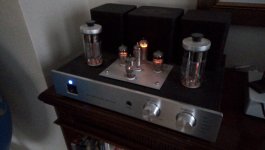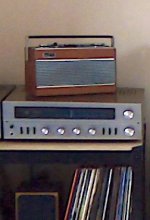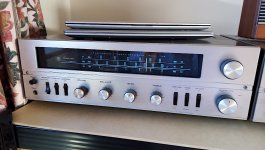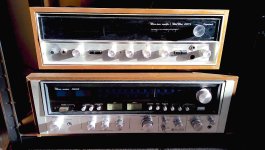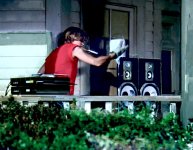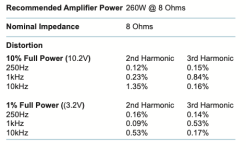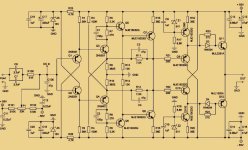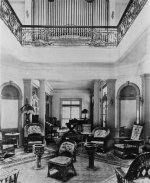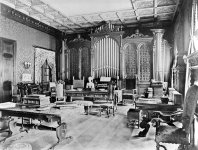You can try and ram the subjective views and ideas that we can't measure everything. This only shows a lack of understanding. My job isn't to train and prove a point, or to individually train each person singaly. It is a massive waste of my time. You have a problem, then do some valid research on your own like I have, and everyone else in my field. Watch out for those who know better but leverage misinformation for commercial gain.
I'm not going to get dragged into debating each person and point over what is well known and established fact. Remember, I do work for Musicians and not only do I understand what you're saying, but those customers have reinforced what is know. Everything we need to know is shown by THD and IMD spectrographs at various power levels. An impulse contains a ton of information as well. Frequency response is a given, and if it is flat well over the range we need, phase response will also be constant, and will vary identically in each channel. Every single subjectivist argument is answered completely if you take the time to learn.
Now, as far as what you might decide you like, that is personal taste. Good for you. One or a few opinions to not raise question over an overwhelming body or other subjective opinion. Like much in society today, it is the tail trying to wag the dog. Like it or not, people how actually do believe a DHT single ended system sounds better than a good system, solid state, feedback and all, are a tiny minority. If this wasn't the case you would see much higher commercial success and a bunch of amplifiers powered by 50C5 tubes on the market. 50L6 if you are determined old school is better. I worked on all that stuff and am more than well aware as to why they no longer exist as active products. The average person doesn't like them as much. That is the real truth.
So when people drag out their questions on what we know, don't depend on those who have done the work to do it for you, spoon feeding you while you argue against every point. No. Sit down, do the work. Buy the proper, good test equipment and investigate if you have to. It isn't our job to break a belief system. We did the work. We invested in ourselves and did buy the equipment, and many have spent our lives looking at this. I'm not asking you to believe me, I'm saying go find out if what I am telling you seems far fetched - or stick your head in the sand and hold onto a faith based idea without real evidence to back it up. The real evidence does not support what some folks are saying, and I told you where it came from.
I'm not going to get dragged into debating each person and point over what is well known and established fact. Remember, I do work for Musicians and not only do I understand what you're saying, but those customers have reinforced what is know. Everything we need to know is shown by THD and IMD spectrographs at various power levels. An impulse contains a ton of information as well. Frequency response is a given, and if it is flat well over the range we need, phase response will also be constant, and will vary identically in each channel. Every single subjectivist argument is answered completely if you take the time to learn.
Now, as far as what you might decide you like, that is personal taste. Good for you. One or a few opinions to not raise question over an overwhelming body or other subjective opinion. Like much in society today, it is the tail trying to wag the dog. Like it or not, people how actually do believe a DHT single ended system sounds better than a good system, solid state, feedback and all, are a tiny minority. If this wasn't the case you would see much higher commercial success and a bunch of amplifiers powered by 50C5 tubes on the market. 50L6 if you are determined old school is better. I worked on all that stuff and am more than well aware as to why they no longer exist as active products. The average person doesn't like them as much. That is the real truth.
So when people drag out their questions on what we know, don't depend on those who have done the work to do it for you, spoon feeding you while you argue against every point. No. Sit down, do the work. Buy the proper, good test equipment and investigate if you have to. It isn't our job to break a belief system. We did the work. We invested in ourselves and did buy the equipment, and many have spent our lives looking at this. I'm not asking you to believe me, I'm saying go find out if what I am telling you seems far fetched - or stick your head in the sand and hold onto a faith based idea without real evidence to back it up. The real evidence does not support what some folks are saying, and I told you where it came from.
I was reading an interesting chat by the late Dan Banquer, head of RE designs and the LNPA-150 amoplifers that Lynn liked so much in his reviews: http://nutshellhifi.com/library/reviewer.htmlphase errors
https://db.audioasylum.com/cgi/m.mpl?forum=prophead&n=17088&highlight=feedback+pass+E-Stat
- discussion thread: https://www.audioasylum.com/cgi/t.mpl?f=prophead&m=17088
I was searching for the schematic, which currently eludes me and looks like it will have to be reverse engineered, although sadly I don't own any of these amplifiers. But I really want to see it 🙂
He mentions the driving of a reactive load with a poorly regulated supply, and how the voltage and current can get out of phase, and the feedback loop does not save this situation.
I think some view PSSR as a cheap way of reducing mains hum, but in simulations I've tried an amplifier with a PSU series resistance and it does affect it, and most of us can listen to the music on the PSU rails, and certainly look at it on a scope probe.. so PSUs and current sources etc, matter perhaps more than we think.
The interesting thing about the LNPA-150 (see Lynn's review, above) is that it appears to have very few transistors and perhaps a very short feedback loop, as a result. These amplifiers, according Dan, had 0.1% THD, but 0.0013% IMD.
It's also a basic transistor amplifier that appears to sound better than many tube amps..
I think people today like to thinks the older designers of the 1960s-80s etc are not as smart as modern designers, despite most of the world visibly dumbing down, but their masterpieces also had to deal with inferior transistors etc, , as 'progress' has been made, someone write earlier about a group that built old designs with modern components - I expect they sound very very good.
The 'measurement vs listening' war is a false war I think. Try a mic, in a room, and look at the difference signal between it and the original input signal - with some delay to account for the air distance etc, and I suspect some of the 'badly measured' designs comfortably beat some of the 'low distortion' designs: with a real music signal.
If would be a really good test, testing every part of the system, so amps and speakers could be swapped in and the system could be tuned to work well as a whole. That's perhaps the only valid measurement - how closely do the compression waves in the air, resemble the waveform fed into the amplifier... ? 🙂
I think we could start measuring this.Is the improvement of auditive performance worth
In the air, with a microphone, with real music.
I think the results of measuring the air vs the input would be very interesting 🙂think that if such "correlation degree" rating existed, it would be from suprising to terrible for some Audio equipments and manufacturers
I don't think we need the subjective element at all, so in this i agree with you.Everything we need to know is shown by THD and IMD spectrographs at various power levels. An impulse contains a ton of information as well. Frequency response is a given, and if it is flat well over the range we need, phase response will also be constant, and will vary identically in each channel. Every single subjectivist argument is answered completely if you take the time to learn.
I think we need to measure with a music signal, and measure the output, ideally from a microphone, vs the input signal.
This would then be a 'complete' measurement, and also account for how well it drives a real speaker.
I think we could start measuring this.
In the air, with a microphone, with real music.
I think the results of measuring the air vs the input would be very interesting 🙂
Possibly ! As long as we can know what we measure, what we compare, and how...
Long ago (early 2000s), I made some attempts to compare I/O like you describe @Globulator. The results unfortunately were inconclusive, despite the use of advanced equipment at that time (sampling oscilloscope, signal generator, B&K 1444 microphone and amplifier, at night, in a high and large silent workshop).
We tested musical messages as well as waveforms (sine, pulses, square, triangle), and the differences and distortions observed on the screen of the scope were so great that we thought that our protocol was probably not good, or rather there was too much dispersions and uncontrollable parameters (known or ignored) to consider the test to be significant or valid.
Things have changed since, but the question of the protocol and the validity of the experimentation or the comparison still remains : that's a point that many Audiophiles ignore honestly or deliberately. But they are not alone !
T
Very interesting!We tested musical messages as well as waveforms (sine, pulses, square, triangle), and the differences and distortions observed on the screen of the scope were so great that we thought that our protocol was probably not good
I think the distortion of the whole system is way bigger than people think.
The nonsense of pursuing low THD is not just from the incorrect assumption that all harmonics are equal, which they are certainly not, but neglects more important aspects.
I found this article, I'd read it some time ago, but it reminded me. It mentions Nelson Pass (Like Lynn, a member here on diyaudio) who's early design ended up in the Usher R1.5 I bought, despite the 40kg and prodigious mains power it hoovers up, because it sounded very good.
http://www.audiophileaddicts.com/2017/07/lower-distortion-often-doesnt-equal-better-sound-quality/
I mentioned TIM earlier, but the speed - risetime or slew rate is part of the reason the LNPA-150 sounded so good, on the surface a fairly basic transistor circuit, but seems to be far more than the sum of it's parts.
Currently I'm listening to Fredrika Stahl, 'Tomorrow', and Delerium, 'Karma' on my little SEP Tube amp (pic), it's sort of vintage now LOL, not as good looking as the 1980s Japanese stuff but it gets a free pass as it sounds like something huge!! 😀
That's another amp that's got nothing special in it. I'm not quite sure why it sounds so musical, so open, but like that LNPA-150, it must cioncide to the 'yet quite to be pinned down in my head' criteria for a great amplifier 😀
I have a Sansui 250 (pic), actually, that I will recap at some stage - and perhaps upgrade the resistors etc - I'd be very interested to see how that compares. I would expect it to do well, maybe coupled to my Grundig Box 550 - which are similarly amazing speakers of the past (they even have factory wool stuffing, while we in England had the 'rather ordinary' Mission speakers LOL.!!)
I'll have to get better photos lol 😀
Attachments
Back in the day (80's), when "vintage" was what people wanted to get rid of, I used to regularly pick a flea market in Chelmsford Mass. RTRs and commercial tapes for them would oft show up, I'd buy them and play around. I noticed the 7.5 ips stuff sounded pretty good, but most, alas, were 3 3/4. Used to find monsters like this for $10 -This sound is so much more accurate and alive than any other repro device I had ever heard.
Interesting brand, Dokorder. They produced some very questionable stuff. Back in the 70s considered their 4-channel 1/4 inch deck but decided against it.
Have been building a library of pre-recorded tapes from the 50s to late 80s because they sound so excellent when played on quality R2Rs. I use a Revox A77 for this purpose. It was the most popular R2R during its day and hundreds of thousands were made by busy Swiss and German craftsman.
Had always thought that 3 3/4 ips tapes were unlistenable and they are on the Pioneer and Sony decks I had. Then I listened to a few on the Revox A77 and Surprise! They actually sound good to very good. Revox understood how to adjust for this slower speed and used completely different adjustment settings -- you restart the machine to accommodate the slower ips speed -- that is, after all, twice as fast as a cassette. If you can get one with Dolby it is excellent.
So, now, buy 3 3/4 ips R2R tapes and, usually, they are keepers.
Of course, the problem with purchasing used pre-recorded tapes is dealing with the wide range of sellers on EBay. Many are dishonest and are selling "recopied" tapes with suspicious boxes. One honorable dealer is Ken's Classic Tapes that usually sends out tested R2Rs ranging from good to excellent in quality. What's more, he packages these as if they were new and opening the boxes is a pleasure by itself. He ships from WA if I recall correctly. Poor tapes can be returned with no questions.
Have been building a library of pre-recorded tapes from the 50s to late 80s because they sound so excellent when played on quality R2Rs. I use a Revox A77 for this purpose. It was the most popular R2R during its day and hundreds of thousands were made by busy Swiss and German craftsman.
Had always thought that 3 3/4 ips tapes were unlistenable and they are on the Pioneer and Sony decks I had. Then I listened to a few on the Revox A77 and Surprise! They actually sound good to very good. Revox understood how to adjust for this slower speed and used completely different adjustment settings -- you restart the machine to accommodate the slower ips speed -- that is, after all, twice as fast as a cassette. If you can get one with Dolby it is excellent.
So, now, buy 3 3/4 ips R2R tapes and, usually, they are keepers.
Of course, the problem with purchasing used pre-recorded tapes is dealing with the wide range of sellers on EBay. Many are dishonest and are selling "recopied" tapes with suspicious boxes. One honorable dealer is Ken's Classic Tapes that usually sends out tested R2Rs ranging from good to excellent in quality. What's more, he packages these as if they were new and opening the boxes is a pleasure by itself. He ships from WA if I recall correctly. Poor tapes can be returned with no questions.
Audio's First Law: the degree of Subjectivism is inversely proportional to the knowledge of Electronics and Acoustics...You can try and ram the subjective views and ideas that we can't measure everything. This only shows a lack of understanding
Haha 😀 It often happens, yes, but the 2nd law may say that the pursuit the THD technical goal is not always the correct goal 🙂inversely proportional
An interesting 4 page interview here, from a man who knows about designing amplifiers, and a member of diyaudio
https://www.stereophile.com/interviews/1191pass/index.html
The pursuit of THD didn't end that well, but the pursuit of stability in all conditions... had some remarkable results, e.g Bob Sickler's Audionics CC-2 and the last iteration of that concept in Dan's REdesign LNPA-150s.
Info of the thinking beyond THD in the CC-2 design can be found here.
http://www.audiophileaddicts.com/2017/07/audionics-oregon-cc-2-distortion-better/
http://www.audiophileaddicts.com/2014/11/slew-rate-matter/
I quite fancy making on of these CC-2s, without the 'questionable' zeners on the LTPs on the inputs anyway, CCS there for me.
A short feedback path tends to favour stability I think, but also the choice of design...
.. I've seen a cathodyne behave better than an LTP in this regard - for phase splitting, in a cathodyne the two phases move at the exact same time. But in the LTP I saw a slight delay as one transistor (or tube) hands over to the other to balance. The balance effort in an LTP is instantaneous - but the time to achieve balance is not... and so it slightly misaligns down the feedback path to use an LTP... i.e. I found less stability.
My SEP amp uses feedback from power tube anode to driver tube cathode.... this is also a very short path, only two tubes to traverse.. the input tube is left to its degenerative feedback, so that's fast too.
I guess slew rate isn't the key either, as some great tube amps don't have great slew rates.
THD appears largely irrelevant.
TIM and IM - perhaps the most important.
But stability rules, because it affects the phase - hence imaging and perceived sound in the ears. So my theory is tha subjective good results are merely confirmation of phase stability - together with detection of higher odd order harmonics, both easy to quantify and measure.
The Japanese amplifiers and receivers didn't clean up in the tube era, because most tube designs were basically the same - standard Williamson GNFB - but not too much - with some type of reasonably fast phase splitter.
But when the transistor arrived, the Japanese cleaned up - which is why we have so many great Japanese vintage gear. Why did they do this? Because they were stable. Stability lead to reliability and good sound. They still sound good today.
And those small Japanese esoteric low power SET amps eventually caught on too - and what overriding character do these have, with their zero feedback or low feedback designs? Stability.
So perhaps there's more distortion in the air than we think, and perhaps accuracy there is due to stability driving reactive loads with mass, inertia, resonance etc., and even amplifiers that measure perfectly into an 8 ohm resistor, 'phase wander' a little when driving real speakers, and while money spent on giant caps, transformers, silicon etc helps that, it doesn't quite beat a simple design with the primary goal of stability in it's requirements spec 😀
So perhaps this is why people like the sound of the vintage stuff: it's here because it's reliable, and it's reliable because it's stable, and that makes it sound good too 🙂
Attachments
Hi Globulator,
Nelson has a commercial interest and is talking from a standpoint of other equipment that doesn't actually measure well. I respect the heck out of Nelson Pass, but he has an interest that he pursues. It's valid from his entire viewpoint, but not from a best sounding performance standpoint. His designs can sound good within their performance limits, bt I have worked with and worked on equipment that sounds far better. You can't accept statements from others without considering their context.
There is more distortion in an entire system for sure. But we need a repeatable standard to measure with, and it has been established. That is the only way measurements between people will ever agree. It wasn't picked to be easy, it was picked to be repeatable. Period, end of story. We do look at stability, current limiting and the effects varying load has on the voltage amp stage. If you aren't aware of this, it is because you don't work in design or service. Listening to others who aren't experts in the field, or have a commercial interest will only confuse and misinform you.
As I said much earlier and consistently. In the 1970's or earlier, we didn't have very good test equipment. It was for the time, but not great. People could hear things we weren't able to measure or didn't understand. That was then, this is now. No longer are those observations true, not even close. Technology and our understanding has progressed far beyond those days and people have to re-evaluate their beliefs to get in tune with what is, not what was. That also means that some folks who proclaimed they were special in hearing ability may be wrong. That is now an ego thing. Therefore it dies slowly and painfully.
Actually, it absolutely is given you are measuring with the correct equipment and also IMD distortion. Both standard metrics.It often happens, yes, but the 2nd law may say that the pursuit the THD technical goal is not always the correct goal
Nelson has a commercial interest and is talking from a standpoint of other equipment that doesn't actually measure well. I respect the heck out of Nelson Pass, but he has an interest that he pursues. It's valid from his entire viewpoint, but not from a best sounding performance standpoint. His designs can sound good within their performance limits, bt I have worked with and worked on equipment that sounds far better. You can't accept statements from others without considering their context.
Yeah. Actually it did and does given modern state of the art test equipment.The pursuit of THD didn't end that well
Feedback paths are short. One resistor, possibly with a small capacitor across it. Designs can be more complicated, but the complexity is in linearizing the signal path. Of course if you have a more complicated circuit, there are more opportunities to get things wrong. But done right, much better.A short feedback path tends to favour stability I think
There is more distortion in an entire system for sure. But we need a repeatable standard to measure with, and it has been established. That is the only way measurements between people will ever agree. It wasn't picked to be easy, it was picked to be repeatable. Period, end of story. We do look at stability, current limiting and the effects varying load has on the voltage amp stage. If you aren't aware of this, it is because you don't work in design or service. Listening to others who aren't experts in the field, or have a commercial interest will only confuse and misinform you.
As I said much earlier and consistently. In the 1970's or earlier, we didn't have very good test equipment. It was for the time, but not great. People could hear things we weren't able to measure or didn't understand. That was then, this is now. No longer are those observations true, not even close. Technology and our understanding has progressed far beyond those days and people have to re-evaluate their beliefs to get in tune with what is, not what was. That also means that some folks who proclaimed they were special in hearing ability may be wrong. That is now an ego thing. Therefore it dies slowly and painfully.
Now that, and we can include J.C., the late C.H. and a bunch of others as well in that, is precisely the heart of the matter. Bruno P. and Lars R., both of whom I have in high esteem, are always dancing on a needle when asked for opinions....Nelson has a commercial interest and is talking from a standpoint of other equipment that doesn't actually measure well. I respect the heck out of Nelson Pass, but he has an interest that he pursues.
Peter Walker, David Hafler, (+Earl Geddes although not an amp designer) were very outspoken in their opposite objectivist view and so are Douglas Self, and the late Randy Sloane.
When you include people you have to look at where their money comes from. What motivates what they may say? Don't discount them, but take it into account an compare what they are saying to what is actually known and where it may conflict with how their money is made.
I hold honest people in high esteem, that means Nelson Pass and Douglas Self, Bob Cordell and others. But honesty comes once you get the entire story. Douglas Self doesn't run an ego and doesn't wish to be a "personality". His research and practical knowledge reflect reality.
Earlier designers had a window on what was correct limited by what they could find out. Test instrumentation wasn't very good by today's standards. They only knew so much. Had these folks had today's equipment you would see much more evolved designs. Now, also keep in mind that a designer becomes "a name" and some on your list suffered greatly by the desire to market their name. They allowed audio lore to cloud reality in order to sell both the product and the name. Truth has no room for ego, it just simply is. When you have to spin a story, chances are you are hiding something.
I hold honest people in high esteem, that means Nelson Pass and Douglas Self, Bob Cordell and others. But honesty comes once you get the entire story. Douglas Self doesn't run an ego and doesn't wish to be a "personality". His research and practical knowledge reflect reality.
Earlier designers had a window on what was correct limited by what they could find out. Test instrumentation wasn't very good by today's standards. They only knew so much. Had these folks had today's equipment you would see much more evolved designs. Now, also keep in mind that a designer becomes "a name" and some on your list suffered greatly by the desire to market their name. They allowed audio lore to cloud reality in order to sell both the product and the name. Truth has no room for ego, it just simply is. When you have to spin a story, chances are you are hiding something.
In DIY luckily one is not constrained to standard metrics 🙂Actually, it absolutely is given you are measuring with the correct equipment and also IMD distortion. Both standard metrics.
In fact no one is really constrained - who actually looks at THD these days? The people I see buying Revolver turntables and Sony headphones .. i.e. the people with money and spending the money, don't know or care what it stands for.
The reason I say the THD is nonsense, because to me it doesn't make sense to use a metric that treats a (e.g.) 5th harmonic, for example, equally to a 2nd harmonic. Listen to this:
We can see the two tones he plays here sound very different, but have the same THD. So what use is THD to listener or buyer?
THD is an appeal to authority, because people looked at the number to tell them how good it is, over and above trusting their ears.
I don't see that.Nelson has a commercial interest and is talking from a standpoint of other equipment that doesn't actually measure well.
Lynn, Nelson, Dan, Bob etc were simply writing of effects that we've all heard, especially in vintage hiFi, where the THD measurement didn't relate to sound quality, and explaining why this might be.
While I understand you have your own position and context, and respect that right, their views are well explained, stand on their own merits and my own ears, and others, concur 🙂 I can follow the logic of stability, simplicity and short feedback paths on my own.
The aim of the feedback is I think, to correct the output? So this feedback must travel to the output.. to arrive there... to correct it!Feedback paths are short. One resistor, possibly with a small capacitor across it.
So the feedback path logically includes the route from where it's fed back into, to the output.
I used the term 'round and round' earlier, wrt GNFB, as a conceptual model I find useful, even if others dislike it. In DIY, the Y is me 😀
Of course if we have to define 'round and round', well, in a simulator each timestep requires a full circuit matrix solution because the whole circuit changes at the same time, (at least within the speed of light in this reality), but a finite slew rate must impose some error itself in the temporal effectiveness of that feedback.
So perhaps I can view the feedback path as being a descending spiral of whole loops, which makes it very long indeed. At oscillation it's of course infinitely long! At the limit - like a 1980s Naim with a short speaker cable, it's just very very long!
As the odd harmonics also multiply with this loop, I can again see why stability and a short feedback path would be useful for an amplifier to sound good... it just makes sense to me in an objective way. That's why I prefer this viewpoint.
I like the optimism, but in that period interest in HiFi has gone from a major aspiration and a HiFi corner in every department store and HiFi shops all over the place, as in the film 'Ruthless People' (1986 - the same year as Peter Gabriel's Sledgehammer), to today where no one cares.In the 1970's or earlier, we didn't have very good test equipment. It was for the time, but not great. People could hear things we weren't able to measure or didn't understand. That was then, this is now. No longer are those observations true, not even close. Technology and our understanding has progressed far beyond those days
The evidence therefore, suggests that perhaps the pursuit of THD didn't do a lot for HiFi sales.
It's a bit like the Cancer Research Charity: Prevalence of cancers when it started, compared to now: do not indicate success.
objectivist view
I think there's a tendency to conflate the rejection of THD as a move away from test and measurement, towards an emotional attachment to subjectivism. But as the test tone video above demonstrates, it's simply the rejection of THD as a useful metric to indicate sound quality. If you can hear the difference, you acknowledge that THD doesn't say much about the sound.
I'm quite happy to use THD to check how linear a DIY circuit is, but I don't see it as a valid goal. I see headroom, transient ability, stability, clipping ability, recovery, impedance, as more important. In fact I modified my Maplin MOSFET amplifier to clip more smoothly, as a result of my non THD testing.
In practice, adults rarely change their beliefs. I think beliefs are the problem: by definition, believing one thing excludes all other possibilities, and beliefs are impervious to facts and logic - they can only be challenged by other, dissonant beliefs. I try to avoid beliefs, by simply using memory and a probability weighting to 'facts'. I have to work at this, but it keeps my mind open.people have to re-evaluate their beliefs
People are going back to vintage gear for a reason. To say they are all wrong, perhaps misses the more important question of 'Why'? as in the first post 🙂
My suggestion of 'why', is because the gear of that time was better built, looked better and sounds better today than stuff that's affordable today, with the benefit that they can happily buy and use it without being sold some high price cables or cryogenically treated fuses 😀.
My rare hiFi shop experience these days is rows of nice looking stuff, but the need to have a bulging wallet and the expectation to book an appointment, decisively select the right equipment, and obediently trot out with the latest Best-Buy gear, until the next visit.
But when I was young and HiFi was mainstream, listening to stuff was easy, enthusiasm for both HiFi and music was strong, and the whole experience in various shops was less than the dentist waiting room experience of today 😀
The music was better too - I think we underestimate that factor. People actually listened to music, and new music was good. In 1979 I bought Pink Floyd's the Wall LP. I still have it. Today we have what - Taylor Swift miming the same pitch edited soundtrack in various stadiums around the world, the music today is a horror.
So when people buy vintage Vinyl, steering clear of the newly pressed £120 special edition remasters, often I think it's their chance to sample a little of the magic we were lucky enough to live through - and these cool glowing receivers are a big part of that. And they sound good 😀.
Attachments
@Globulator writes:
"The music was better too - I think we underestimate that factor. "
Throughout the 80s and 90s I was a professor of music history at Universities, Conservatories, and Schools of Fine Arts. We would regularly go out to high schools to work with the band and choral teachers for potential students. They all said the same thing: "we can't get the best musically-inclined students to go into music -- they know they can't make a living."
And it's even worse now.
The downturn in audio equipment started earlier this century but it started much earlier for musicians. Those of us who were teaching in the 80s noted that students were much more visually oriented than sound oriented.
And it's even worse now.
Looking for explanations outside of the culture and the relative importance it places on music wastes your time. I purchase world-class grand pianos for home and studio from the German maker Schimmel (now Chinese owned). They keep thinking that they will correct the problem by building better grands. Total nonsense. The instruments they are building now are the best ever made. And no-one buys them because...
The culture doesn't place value on music. It's cheap. It's free. It can't possibly have value.
No music stores selling good quality repro equipment -- save the occasional Best Buy Magnolia salon. Stores that sell high-end musical instruments have largely dried up. The culture places little value on music, period.
"The music was better too - I think we underestimate that factor. "
Throughout the 80s and 90s I was a professor of music history at Universities, Conservatories, and Schools of Fine Arts. We would regularly go out to high schools to work with the band and choral teachers for potential students. They all said the same thing: "we can't get the best musically-inclined students to go into music -- they know they can't make a living."
And it's even worse now.
The downturn in audio equipment started earlier this century but it started much earlier for musicians. Those of us who were teaching in the 80s noted that students were much more visually oriented than sound oriented.
And it's even worse now.
Looking for explanations outside of the culture and the relative importance it places on music wastes your time. I purchase world-class grand pianos for home and studio from the German maker Schimmel (now Chinese owned). They keep thinking that they will correct the problem by building better grands. Total nonsense. The instruments they are building now are the best ever made. And no-one buys them because...
The culture doesn't place value on music. It's cheap. It's free. It can't possibly have value.
No music stores selling good quality repro equipment -- save the occasional Best Buy Magnolia salon. Stores that sell high-end musical instruments have largely dried up. The culture places little value on music, period.
Hi Globulator,
You are raising a cloud of uncertainty when there is none. Chasing THD and IMD has produced far better equipment, and much better sounding equipment by any metric. Stop picking at poorly performing equipment, because every era and basic design has those. Compare the best. Otherwise you are comparing Pintos and Corvettes for performance.
Now if you decide that you like a certain type of distortion, that is not high fidelity by any stretch. What is is, is something you like. Period.
There are many things that can negatively impact the sound quality. Professionals in the design field looking to make the best equipment by technical standards take care to get everything right.
DIY isn't constrained by anything, quite right. So you ask yourself what you want. You want the best quality you can build? Fine, build it. You want to build something that makes a flavour of music, okay, but accept it isn't accurate. Be honest with yourself and others. I haven't got a problem with people who want to build something like a SET design using parts from the 1920's, except they are using up stock that should be used for restoring that old equipment. Otherwise have at it. I do have a problem when they say it is better for reproducing music, because that isn't true. If it were, that's what the market would be selling. Again, just asking for honesty. That is what is lacking in the very high end market and most of the audio industry these days. Honesty coupled with quality.
Now if you want to compare equipment, you most definitely are constrained by standards. Otherwise you have no reference. No reference, no legit comparison.
You are raising a cloud of uncertainty when there is none. Chasing THD and IMD has produced far better equipment, and much better sounding equipment by any metric. Stop picking at poorly performing equipment, because every era and basic design has those. Compare the best. Otherwise you are comparing Pintos and Corvettes for performance.
Now if you decide that you like a certain type of distortion, that is not high fidelity by any stretch. What is is, is something you like. Period.
There are many things that can negatively impact the sound quality. Professionals in the design field looking to make the best equipment by technical standards take care to get everything right.
DIY isn't constrained by anything, quite right. So you ask yourself what you want. You want the best quality you can build? Fine, build it. You want to build something that makes a flavour of music, okay, but accept it isn't accurate. Be honest with yourself and others. I haven't got a problem with people who want to build something like a SET design using parts from the 1920's, except they are using up stock that should be used for restoring that old equipment. Otherwise have at it. I do have a problem when they say it is better for reproducing music, because that isn't true. If it were, that's what the market would be selling. Again, just asking for honesty. That is what is lacking in the very high end market and most of the audio industry these days. Honesty coupled with quality.
Now if you want to compare equipment, you most definitely are constrained by standards. Otherwise you have no reference. No reference, no legit comparison.
The 'measurement vs listening' war is a false war I think. Try a mic, in a room, and look at the difference signal between it and the original input signal - with some delay to account for the air distance etc, and I suspect some of the 'badly measured' designs comfortably beat some of the 'low distortion' designs: with a real music signal.
If would be a really good test, testing every part of the system, so amps and speakers could be swapped in and the system could be tuned to work well as a whole. That's perhaps the only valid measurement - how closely do the compression waves in the air, resemble the waveform fed into the amplifier... ?
We tested musical messages as well as waveforms (sine, pulses, square, triangle), and the differences and distortions observed on the screen of the scope were so great that we thought that our protocol was probably not good, or rather there was too much dispersions and uncontrollable parameters (known or ignored) to consider the test to be significant or valid.
The problem with 'Full Front to End' comparison ( effectively using a comparator ) is that it actually requires either an anechoic room or a
symmetrical room treated to have a flat RT ( reverb time ) because there are so many room-modes in different places with a 'regular' domestic room.
If you move the microphone even one foot/30cm, your measurement results change.
Being an 'Electro Mechanical' device, speakers are STILL the weakest link in the chain and as such warrant separate measurement.
A variety of complex waveforms + rise & decay times are actually key requirements for measurements that go beyond just
1 frequency THD & 2 frequency IMD.
Now if you want to compare equipment, you most definitely are constrained by standards. Otherwise you have no reference. No reference, no legit comparison.
The question is : what are you comparing ?
T
I read a lot about the 432Hz vs 440Hz issues, I wonder if that had an effect?The downturn in audio equipment started earlier this century but it started much earlier for musicians. Those of us who were teaching in the 80s noted that students were much more visually oriented than sound oriented.
J.D.Rockerfeller, (the well known musician .. - oh, wait, oil, (from both wells and snakes) - insisted upon pushing the 440Hz standard, which many say is discordant.. back in the 1800s many fine old world houses had pipe organs, music was everywhere.
Today's pitch-edited vocals ensures we stay there, exactly! It's as if the 'soul has been systematically removed from music - no wonder people lose interest.
People like Brendan Kavanagh I like, they still interest passers by, bringing the real music to people!
I came across this last night, happenstance, as I'd seen a review of a cheap 20W Class A clone, so I was looking at clones:Chasing THD and IMD has produced far better equipment, and much better sounding equipment by any metric. Stop picking at poorly performing equipment
This is a design everyone loves, and it's not even the original $53k build, it's a cheap $500 build.
Everyone loves it. Why?
Agreed, it's not easy, and what's the lowest distorting loudspeaker? 3%?Being an 'Electro Mechanical' device, speakers are STILL the weakest link in the chain
Tannoy used to publish distortion numbers, but few do, because it's difficult to measure, and it's always high.
THD of the Tannoy V8 starts over 0.6% at 2.5W and goes well over 1% at 25W, and that's just the 2nd and 3rd harmonics summed.
What is the point of a 0.001% THD amplifier, when the speaker throws off at least 3000 times the THD?Now if you decide that you like a certain type of distortion, that is not high fidelity by any stretch.
Clearly in the real world, THD is not a worthy goal unless you manufacture speakers...
The chinese also clone is to the last details, BTW: https://vpayaem.ru/circuits_dartzeel.html
So what is it, this amazing amplifier that everyone likes?
The Dartzeel NHB-108 (The cheap model one, $18k):
https://6moons.com/audioreviews/dartzeel/108.html
I think we need to define 'better'.I do have a problem when they say it is better for reproducing music, because that isn't true.
The comments in the video are not from the chinese makers of the amplifier, or the original designer, but do indicate that many consider it 'better'. All the comments in the video are from people who think the Dartzeel design is better. They can't all be lying, maybe they are just 'wrong'.
Well that's possible, of course, but can a customer ever be wrong? Or is our 'better', different to their 'better'?
Or perhaps they are telling us something. Maybe we should look for the objective explanation, perhaps from the designer?
From the 6moons review:
Hervé believes that IMD, like THD, is not musically detrimental and therefore benign at low levels. If THD and IMD are not culprits for poor sound according to this view, what is? Transient Intermodulation Distortion (TIM). It "...occurs when the negative feedback (NFB) loop is in a state of overflow, something that arises more often than you might think since the NFB correction always is applied after the phenomenon to be corrected appears. During these very short intervals, the amplifier can produce more than 100% THD and/or IMD." darTZeel prefers to call it Temporal Distortion. This insidious audible distortion screws up amplified sound and is what the NHB-108 seeks to eliminate. By applying several small local negative feedback loops instead of a global loop and extending frequency response to reduce phase shifts, Temporal Distortion (TD) is claimed to have been eliminated.
And again that TIM crops up, as written about by Lynn Olson in the previous links of nutshell HiFi, discussed by Nelson Pass too, and various successful audio designers.
Perhaps the fact that people like the sound of amplifiers designed for stability, and without super-low THD numbers (only attainable via hard GNFB), points towards TIM being a real, audible metric.
The old Japanese amplifiers didn't have great THD numbers but people liked them, and listened to an awful lot of music on them. So perhaps the question for todays designers is: 'Why are you chasing THD and IMD, when many customers prefer amplifiers with very mediocre THD and IMD numbers?
I think the issue here is that I, and many others, don't accept THD + IM is a meaningful measure of accuracy.You want to build something that makes a flavour of music, okay, but accept it isn't accurate. Be honest with yourself and others.
I'm guessing my speakers have about 5%+ THD, when I compare my Usher R1.5 to my SEP amp, the basic sound is the same.
How? The amplifier THD is quite different, but the total THD is what, 5.001% vs 5.5% ?
The SEP (with OPT outside of the feedback loop) just gets the edge for openness, ambience.
The reason Vintage amplifiers are popular, I suggest, is because THD is not so relevent.
The Dartzeel reviews well, people love the sound, this 'cloud of uncertainty' - it's not mine, it's been there for a long, long time 😀
The question is : what are you comparing ?
I think in an industry struggling for sales and interest - there's another question:
- "Why not build what people like?"
For decades there has been a doctor-patient 'prescriptive' attitude in HiFi. Over these decades of 'progress' (along with the worst public health in known history) HiFi is now a dying niche industry, a shadow of it's former 1970s self, the time when all those 'bad' amplifiers were being snapped up by the truckload, to glow serenely in living rooms across the world 😀
When speakers have sub 0.1% distortion I'll be right there to chase down amplifier THD to, but until then, what's the benefit?
Attachments
As people have been trying delicately to say for past 6 pages, it’s NOT the total distortion at full power that matters. It’s the NATURE of it, over the entire dynamic range, that matters. There are many ways to get to .005% distortion, and some are simply worse than others. Todays measurement equipment, applied properly, will pick out the differences.
- Home
- Member Areas
- The Lounge
- Antique gear
